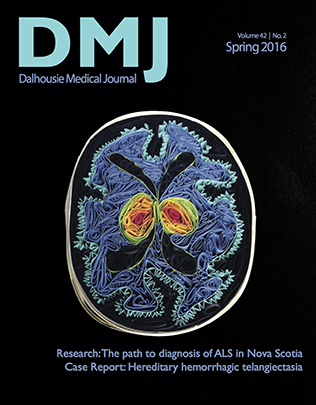The path to diagnosis for persons with ALS in Nova Scotia
DOI:
https://doi.org/10.15273/dmj.Vol42No2.6675Abstract
Purpose: The purpose of this study was to examine the route to diagnosis of persons with Amyotrophic Lateral Sclerosis (ALS) in Nova Scotia.
Methods: Nova Scotia clients of the ALS Society of New Brunswick and Nova Scotia described their perspective on their route to a firm diagnosis of ALS, including processes that worked effectively as well as barriers to expedited care. Clients were selected from all who had been diagnosed in the previous two years and who were able and will- ing to participate in the interview.
Results: Fifteen interviews were completed. From two to 42 months elapsed between the time of initial symptoms and firm diagnosis of ALS being made. The path to diagnosis was ’‰¤6 months for five individuals and was ’‰¥18 months for five others. Mean duration of time elapsed between the first symptoms and the firm diagnosis was 14.4 months with a median of 11 months.
Conclusions: Persons with ALS in Nova Scotia have similar paths to diagnosis compared to those in other countries. Considerable delays occurred in persons with initial bulbar symptoms and in those cases where ALS was not con- sidered a diagnostic possibility early in the course, due to lack of provider awareness or atypical initial symptoms and signs.
Downloads
Published
How to Cite
Issue
Section
License
Authors who publish with this journal agree to the following terms:
- Authors retain copyright and grant the journal right of first publication with the work simultaneously licensed under a Creative Commons Attribution License that allows others to share the work with an acknowledgement of the work's authorship and initial publication in this journal.
- Authors are able to enter into separate, additional contractual arrangements for the non-exclusive distribution of the journal's published version of the work (e.g., post it to an institutional repository or publish it in a book), with an acknowledgement of its initial publication in this journal.
- Authors are permitted and encouraged to post their work online (e.g., in institutional repositories or on their website) prior to and during the submission process, as it can lead to productive exchanges, as well as earlier and greater citation of published work (See The Effect of Open Access).


